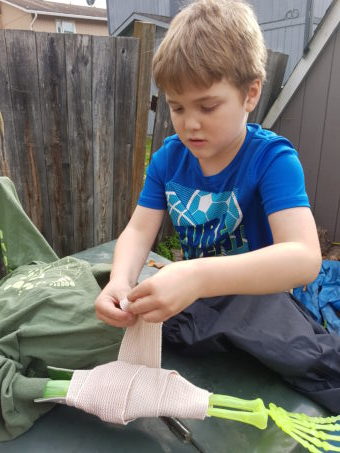 If you are looking to teach your interested child (4th-9th grade perhaps, but suitable when adjusted for younger and certainly older) decent, in-depth, First Responder Skills, than you have come to the right place!
If you are looking to teach your interested child (4th-9th grade perhaps, but suitable when adjusted for younger and certainly older) decent, in-depth, First Responder Skills, than you have come to the right place!
Does this curriculum line-up offer a day-by-day detailed plan? No. Sorry. (Though not really.) This isn’t for the easy-generic-elementary-text-book-following kind of folks. It is, however, great for any young child who has a passion for helping others during medical need and a parent who is also passionate about learning themselves. You will need to be able to walk your child through rather detailed information, by reading to/with them, having many discussions, and with hands-on training and projects. If that all sounds awesome to you, than this is for you!
I came up with these plans in response to my 6 year old’s desire to become a Fireman. This particular Home Page offers links with more detail to each of the units we covered for the First Responder learning. (There is also a page for details about our Elementary Firefighter Skills training.)
This learning would be considered Science: “Human Anatomy” and “First Aid” on an ILP, and is intended to be a 7 unit study, covering the subject through one whole school year. The reason for this is that the information is quite detailed and requires a lot of discussion and hands-on (‘play’ if you may) and practice (AKA ‘review’) to make sure the information is truly understood and grasped. But don’t let that intimidate you. In fact I have found it relieving that I am not having to push to accomplish a certain number of pages or worksheets each day or week.
As I said just a moment ago, this isn’t your typical curriculum, and barely even a ‘curriculum’ at all. In fact, it would probably be considered Unschooling because it really is so much real-life learning, but call it what you will, it is working GREAT with my son. It’s really a lot more like learning together (as in-fact we really are) and a journey through a story, than a class or course.
Alright, so how did I come up with this plan? Simple. I looked at the few resources I already owned and added a few more that were detailed and colorful with charts and such. I then balanced it out with others that would be easier and perfect for stepping into each subject before fleshing them out with as much detail as my son would be able to grasp. It is never a bad thing to read some of the same information again, written slightly different. Each book brings different details into light.
I can imagine that reading through the list of resources and each unit, this might seem like a lot for some folks, and if nothing else perhaps my system helps you brainstorm some ideas for your own curriculum and game-pan. However, even though it isn’t a day-by-day guide I do lay out each chapter and specific pages for each unit. If you simply use it as a check list and go at your own pace it really won’t be that different.
Resources (all photographed below, with some links for your convenience):
Although I suppose that one textbook and one lab book for the year would be considered both ‘normal’ and minimal, I don’t feel that what I have listed is too extravagant. Much smaller than a textbook, a few books are the reading texts and a few are the project plans/experiment resources. Above all, I suggest buying your books used. Save yourself some money, and you also don’t have to worry about making notes in them!
First off, DK’s “The Human Body Book” by Parker was hand selected for purchase after reading through a dozen similar books. I like the chapter lay-out, with nice full length charts for each body system, and that it has several pages detailing the different parts there-in, but especially the last section of each chapter which discusses, in easy to understand terms, many different ailments for that specific system. THIS is what makes it great for this First Responder Training.
Then next book pictured again has a great informative intro page for each body system, but also a LOT of hands on projects. Some of them are really quick and easy, while others would take more time and planning. I already owned this thrift store find, and when paired with Scholastic’s very cheap“Make It Work: Body” book (upper-left, third photo) you gain the ability to pick and choose what type of projects you would like to do, based on your personal time and resources. Another cheap Scholastic choice, “The Body Book” (Last photo) is also a simple ongoing coloring and cut project in which you build a body that opens to expose the organs.
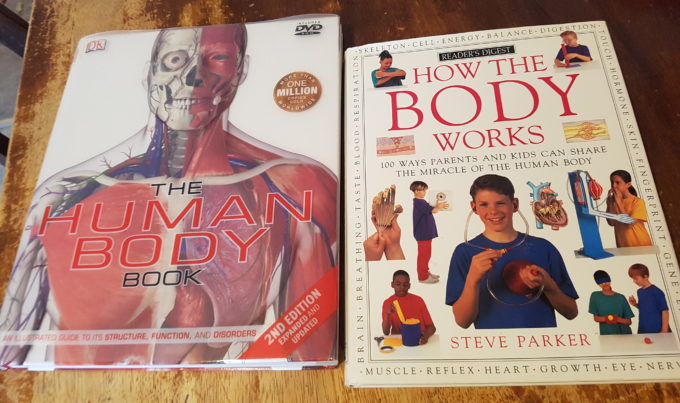
Second to the Human Body Book, the other major resource for the bulk of our learning would have to be this “Outward Bound: Wilderness First-Aid Handbook.” I got it with my adult Wilderness First Responder Class 10 years ago. You might want to read through it ahead of time to get a good understanding of their system of response before you try to teach it to your child, however it is written in very easy language and contains a great glossary. There is a workbook that can also be purchased (I use the 5th edition but the 6th has the same scenario – again, it was what I had) for some great real-life accident stories for responder practice/training. The answers are all detailed in the back of the book. My son and I really like talking through each scenario. It’s a bit like a ‘who-done-it’ but for trauma. LOL (There are also a few of those right in the handbook, and they have more editions if you want more scenarios.)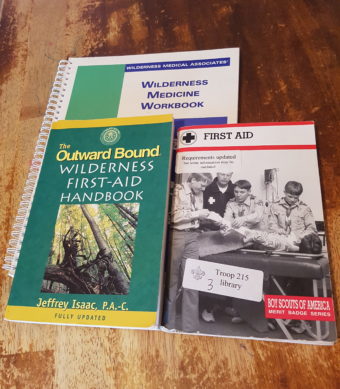
Also pictured above is an old Boy Scout first-aid book that I was handed-down from a cousin. If the Outward Bound book seems to be too detailed for the kind of first-aid your child would like to learn than a simpler first-aid guide such as this one or another great option, the John Hopkins’ “First Aid for Children Fast” (below) are excellent choices. It has very child friendly photos and a lot of first-aid skills.
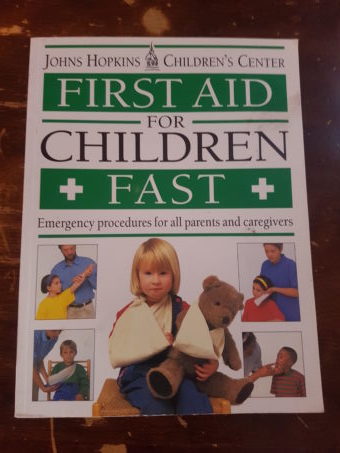
Below, “The Heart” was a book I happened to already own, but the “Body Battles” book is really a great one for laying out exactly how our body and blood responds to illness and injury. (The three books in the middle are not part of this curriculum. They were specifically added for my son’s schooling because he has Cystic Fibrosis.)
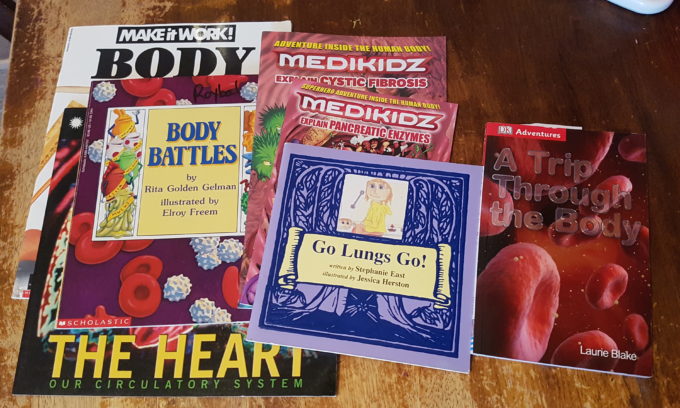
That leaves the last two books, “Through the Body” (above) and “The Bones Book” with the skeleton kit (below). Both are really easy reading; perfect for young readers and young listeners. I included them, using each chapter separately, as simple introductions to each new unit. As mentioned above, hearing something more than one way can be very beneficial for learning, and as with the first-aid books, if you have a young child or want to simplify this learning these two books will fit right in line.
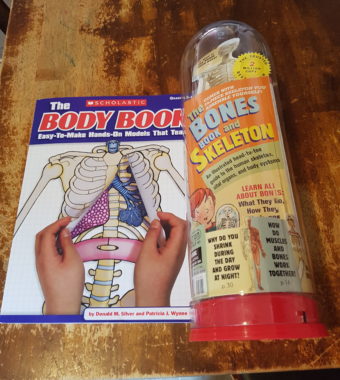
Okay, so you have some resources to work with, but what’s the plan?!
We spend about 20 minutes two times a week studying from one of the above books. I organize this reading first by only going through the chapters that correspond with the unit we are in. For instance we read the skeleton chapter from each book for the first unit, but within that I break it down even farther by beginning with the easiest reading and ending with the most detailed. A third learning session each week is reserved for projects and other fun play/learning. We spend several weeks on each unit, (even 4-6,) as much as needed with everything else we have going on, and with only 7 units there is plenty of room for holidays, sick days, field trip days…
Below is a lay-out of the units. Each is (will be) a link to it’s own page detailing specific chapter, pages, and activities, from the books above, as well as field-trip suggestions. They come with some part memorization and charts, hands on projects, and exploration, but mostly a lot of reading and discussion, and several Boy Scout-like skill checks. The goal is to be able to do some mock emergency scene size-up and care. Your child may even be able to get their CPR card, depending on age and ability.
Each page is also our family’s blog of the process through the unit, and how it worked for us.
For this list each Unit is broken down with the Anatomy learning for a specific body system, then first-aid skills for that system, and finally the particular vital sign that goes with it.
- Human Anatomy; First Aid, *Vital Signs:
- Bones and Joints; Brakes and Splints
- Muscles; Sprains and Treatment
- Skin; Abrasion Care and Burns, *Reading Color and *Temperature
- Circulatory System; The Heart and Blood, *Reading Blood Pressure and *Pulse
- Respiratory System; Asthma and Bronchial Spasm, *Counting Respirations
- Nervous System and Brain Anatomy; Spinal Injuries and Inter Cranial Pressure, *Consciousness (AVPU)
- Digestive System and Fluid Filtering; Choking
I hope that my lay-out is either just what you needed or just the right inspiration for you in homeschooling your child[ren]. I firmly believe that children are incredible sponges and that if they have a dream we shoot as high as the sky to help them achieve it. I homeschool so that we are not limited by ‘standard rules,’ and have found it to be 100% successful.
Drop me a note and let me know if you like these ideas, if you have used some or all of the suggestions, or what you have chosen to try for your own family. We can ALWAYS learn something from each other!
KEEP LEARNING!

Post a comment